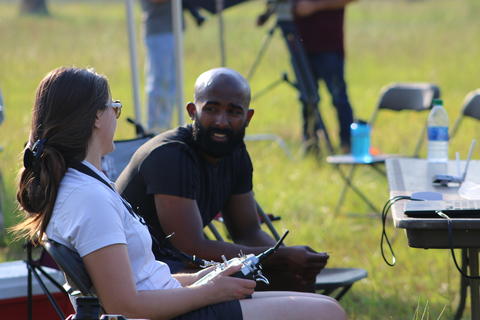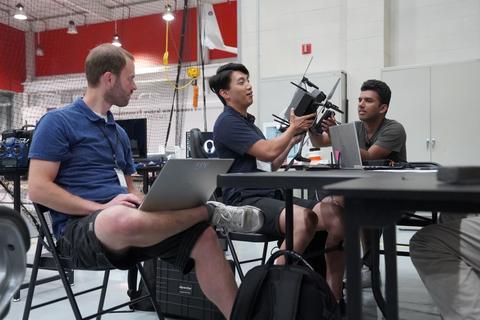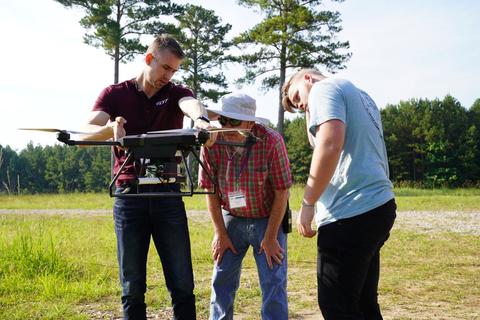First Responder UAS Triple Challenge – LifeLink: UAS Data Relay (UAS 3.2)



Challenge overview
The purpose of the First Responder Unmanned Aircraft System (UAS) LifeLink Challenge (UAS 3.2) was to improve communications for first responder teams on the ground with a UAS carrying a network device in the airspace above the mission area. Contestants in this challenge were asked to design, build, and fly a complete UAS solution that provided first responders with continuous Internet Protocol (IP) connectivity while dispersed in a thick forested area with degraded cellular coverage and no available GPS (Global Positioning System) signal.
Based on concept papers (Stage 1) and demonstration videos (Stage 2), the contestants who met the evaluation criteria and had an operational UAS were selected to participate in the final live competition (Stage 3), which was hosted at a forest near Mississippi State University in Starkville, MS. While the test area had cellular coverage, the communications system on the UAS was tested as a standalone network that did not leverage existing cellular networks. The metrics collected at the live event included: the maximum distance that a UAS carrying a network device could transmit a data signal to a User Equipment (UE) handset, the maximum throughput that the networking device could achieve to a single UE, and the maximum continuous data connection that the network device could maintain to multiple UE’s distributed at different locations in an omni-directional pattern from the UAS. For each scenario, the UAS hovered at a fixed GPS coordinate location so that accurate horizontal distance measurements could be recorded, and then each contestant determined the ideal altitude at which their solution would operate. Each system was evaluated based on a combination of its performance during each of the three test scenarios in addition to learning the effects of directional antenna strength and network design.
Challenge results
Each contestants’ UAS solution that was represented at the final stage of the 3.2 LifeLink challenge created a Wi-Fi network to establish data connections to each UE. Due to problems encountered by several contestants prior to the start of the live competition, only two contestants were capable of flying their systems for evaluation. One contestant utilized a high gain antenna which delivered high-speed data rates to distances of up to about 200 meters from the UAS. The orientation of the antenna on their UAS was likely not optimized correctly for the distance test; however, its data rates were the highest observed during the competition. The other contestant system leveraged a UAS-based mesh radio system which had battery operated repeaters that accompanied each first responder UE. While their data rates at each UE location were lower than the maximum data rate of other solutions, their system was able to maintain a solid connection to UEs at 800 meters from the UAS hover location. The mesh network of this network design may have been able to obtain a larger maximum distance with better optimization and spacing. Both designs hold promise for first responder applications but would require additional development to fine tune the system for maximum performance and reduce the deployment time of the system.
For more information on winning solutions, click on the team names in the Stage 3 chart below. For more information on the overarching First Responder UAS Triple Challenge, including the other two challenges, please visit: 2021 First Responder UAS Triple Challenge | NIST.
Challenge winners by stage
Stage 3: live test and evaluation winners
| Award | Winner | Amount |
|---|---|---|
| 1st place | Team ARCC from Penn State University | $40,000 |
| 2nd place | Team ManTech / Flyt Aerospace | $20,000 |
| 3rd place | Team EpiSys | $10,000 |
| First Responder's Choice Award | Team ARCC from Penn State University | $5,000 |
Stage 2: video test and safety evaluation and walk-on evaluation
The following winners each received $5,000 in prize awards and an invitation to participate in Stage 3: Live Test and Evaluation:
- Team ARCC from Penn State University
- Team Autonomous Aerial Vehicles
- Team EpiSys
- Team ManTech / Flyt Aerospace
Stage 2: check-in review
The following winners each received $3,000 in prize awards and an invitation to participate in Stage 2: Video Test and Safety Evaluation:
- Team ARCC from Penn State University
- Team Autonomous Aerial Vehicles
- Team EpiSys
- Team ManTech / Flyt Aerospace
- Team Pebbles
Stage 1: solution description
The following winners each received $7,000 in prize awards and an invitation to participate in Stage 2: Check-in Review:
- Team ARCC from Penn State University
- Team Autonomous Aerial Vehicles
- Team EpiSys
- Team ManTech / Flyt Aerospace
- Team Overwatch Aero
- Team Pebbles
- Team Squishy Robotics
UAS 3.2 was hosted by NIST’s PSCR Division and managed by Kansas State University, in partnership with Mississippi State University.

